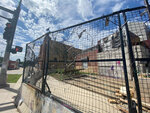


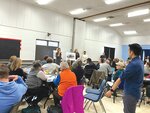
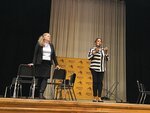
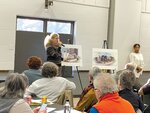







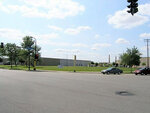
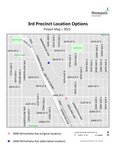
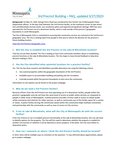


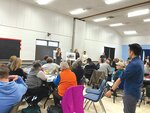
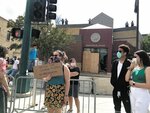
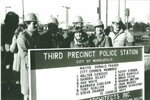
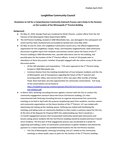
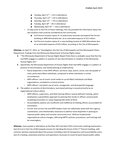
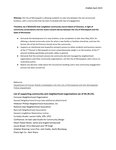


What should Minneapolis do with its police force?
The question continues to generate intense discussions. The 3rd Precinct –the same precinct that Derek Chauvin belonged to and trained officers at despite former complaints prior to murdering George Floyd – was under the microscope during a series of five conversations held in mid-April about the future of the building at Lake and Minnehaha.
As the third anniversary of Floyd’s murder approaches, the city paid out another $9 million in police brutality claims, bringing the total since 2006 to $90 million. Settlements for Chauvin alone have cost taxpayers over $35 million. At the same time, the city has spent more than $25 million in PTSD settlement claims by officers. MPD is a $200 million department and officers are not required to carry professional liability insurance, which means that the public pays for all misconduct lawsuit settlements.
Minneapolis just reached an agreement with the Minnesota Department of Human Rights on steps they will take to address a pattern of racially discriminatory policing, which some say doesn’t go far enough to bring about real change.
In the midst of that, residents expressed their frustration that the city’s five conversations on the 3rd Precinct came three years after George Floyd’s murder, were organized in only six weeks, and were limited to discussing two options for a new building to house the 3rd Precinct.
The sessions were held April 11 at Hook and Ladder (next door to the 3rd Precinct building), April 13 at Midtown Global Market, April 15 at Roosevelt High School, April 18 at Keewaydin Recreation Center, and April 19 at Sabathani Community Center.
In all, about 650 people showed up to the meetings. They began with a welcome by Karen DeYoung of DeYoung Consulting Services, brief information from Minneapolis Interim Chief Operating Officer (COO) Heather Johnston, and a short question and answer session. Then participants were broken up into smaller groups with facilitators to answer a series of questions.
DeYoung explained that their role as facilitators was to listen, pull into a report, and present that to the city. “Our role is to reflect the community,” she said.
The information that Johnston shared shifted from meeting to meeting and focused on the two options the city presented:
• A: to extensively renovate and expand the former building at 3000 Minnehaha Ave. at an estimated expense of $12 million.
• B: a new building located at 2600 Minnehaha Ave. at an estimated expense of $24 million.
“It’s been three years of hell over here, and I am extremely motivated to prevent the insult of rebuilding the old precinct on the existing site,” 30-year Longfellow resident, business owner and filmmaker Paul Irmiter wrote to local officials after attending the first meeting. “The meeting did little to build trust. Not one of those who spoke was from the neighborhood/ community.... How would it be possible to share information with city leaders when none of them attended the meeting? What is the point of collecting data when the decision has already been made?”
WHY ISN’T THE SURVEY OPEN-ENDED?
Some residents and leaders pointed to the “false choice” the meetings and online survey offered, as they merely asked citizens to pick whether they want to rebuild the precinct at Lake and Minnehaha or construct a large, new building at 26th and Minnehaha. People were not able to complete the survey without picking one of the two options. They were not able to state that they didn’t support either option.
At the start of the community engagement process, residents asked that the online survey be changed so it didn’t require picking an option to finish it. That had not been done by the last meeting. DeYoung stated that they can track how many people started the survey but did not finish it. Those at the meeting were able to completed a printed survey and could opt not to answer the question of which option they preferred.
WHY THESE TWO OPTIONS?
At the April 18 meeting at Keewaydin, Minneapolis Director of Property Services Barbara O’Brien provided some information on site criteria, preferred conditions and potential site obstacles. This was a new handout not provided at earlier community meetings. Johnston said it was provided in response to questions at the earlier meetings.
“Why was the community not consulted on the criteria?” asked several attendees.
O’Brien stated that at over two dozen sites were considered between July 2020 and December 2022; the majority were located along Hiawatha Ave. and none in the southeast part of the precinct. She referenced general federal, state and city criteria but did not point to anything specific.
The two consultants the city used, along with administration staff and the police department, looked for sites located within the 3rd Precinct geographic boundary that were a minimum of 1.5-acres and had two points of entry/exit.
“I do not like either option and definitely do not want the police to return to the Lake and Minnehaha location. I would like to see more information about the other sites they considered and why they were eliminated as options,” remarked Kathleen Lenk. “I also would like to know how they decided on the ‘requirements’ for the site. They said one requirement was that it be ‘centrally located’ in the precinct, and neither proposed site is near the center of the precinct (that extends to 35W and south to the southern border of the city). I would like them to consider smaller multiple sites. I think the residents and businesses of the 3rd Precinct should help decide the requirements for the precinct location(s).”
WHY THE FAST TURNAROUND?
Citizens also questioned why these meetings were pulled together so quickly and condensed into a short period of time.
The information on the two sites was presented 13 days prior to the first of the meetings. Initially, it was supposed to be a 12-month engagement process. (See sidebar)
“It’s a runaround,” said 23-year Keewaydin resident Shawn Holster, who attended two meetings and heard about other meetings from neighbors. “And I still want to know why they can’t provide answers to questions that have been repeatedly asked. It reminds me of when they tore up 50th St. a bunch of years back. Here are the options, this is what you’re going to get, now let’s give you the appearance of having input.”
He added, “Few feel heard. They feel as this process is an exercise in futility, and that it is a PR gesture, not genuine.”
LCC CALLS FOR DELAY IN CITY DECISION
A year ago, on May 16 and 29, 2022, the Longfellow Community Council (LCC) held community discussions to gather input from residents and business owners about the future of the 3rd Precinct building at 3000 Minnehaha Ave. A total of 200 people attendeed and filled out surveys. Seventy-five percent were opposed to the 3rd Precinct being located at 3000 Minnehaha Ave.
Common themes from the meeting included lack of trust between residents and the City of Minneapolis, lack of transparency regarding the future of the 3rd Precinct and ensuring public safety, and concern that in 2022, two years after murder of George Floyd, there had been very few opportunities for community conversations.
“Last May, in an effort to commit the city to centering resident voices in all future decisions, I led my colleagues to allocate $100,000 for community engagement about the future of Lake and Minnehaha,” remarked Ward 2 Council Member Robin Wonsley in her e-newsletter on April 6. “Last week, I was shocked to learn from the Interim COO that the Mayor had sidelined the original intent of my allocation to instead focus engagement around the relocation of the 3rd Precinct Police facility. This was a complete bait and switch.”
“Since murdering George Floyd, the MPD has also killed, whether intentionally or through recklessness, Norman Truman, Dolal Idd, Amir Locke, Leneal Frazier, Demetrius Dobbins, Jr., Jamontae Welch, Cortez Williams, Jr., and Tekle Sundberg,” pointed out a handout distributed to people from Communities United Against Police Brutality, which is based at Cedar and 42nd and meets every Saturday at 1:30 p.m. “Countless others continue to be brutalized and harassed.”
“Aggressive policing was standard practice for some 3rd Precinct officers when dealing with suspects of nonviolent, low-level crimes, often involving people of color,” said Abigail Cerra, who has been a public defender and chair of the Police Conduct Oversight Commission, which was disbanded in early 2023. “My clients were constantly getting anal searches. Not at the hospital. At the Third Precinct.”
Joel Albers has lived in Howe since 2008. He doesn’t support either of the city’s two options. “Both locations, 3000 Minnehaha and 2600 Minnehaha, would be located in predominantly BIPOC residential communities. What is required is first an understanding of the trauma imposed on the populations of Black, Native American, Brown and People of Color, both current and historic in Minneapolis, Minnesota and the U.S.; by systemic and institutionalized racism, especially police brutality,” said Albers.
At the April community meetings, attendees continued to “express a lack of trust in the City of Minneapolis process for deciding the future of the 3rd Precinct building, with common opinions expressed about the process including a lack of transparency and accountability, and a lack of a healing, restorative practices and operations necessary to move forward toward public safety,” pointed out the LCC in a board resolution passed on April 18. (Read full resolution at www.LongfellowNokomisMessenger.com.)
Longfellow Community Council Board of Directors:
• Demands the development of a new timeline, to be completed no later than May 2024, for defining a shared community vision for what a new facility or facilities should be, and how the former site of the 3rd Precinct should serve the community.
• Supports an intentional and respectful outreach process to allow residents and business owners of the 3rd Precinct in Minneapolis to more comprehensively weigh in on the location of the 3rd Precinct building specifically and public safety in general.
• Rejects any decision made about the 3rd Precinct building until a new community engagement process has been carried out.
Comments
No comments on this item Please log in to comment by clicking here